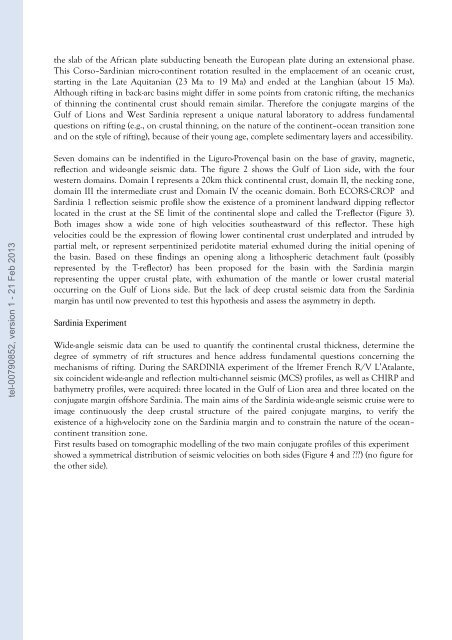Quantification des flux sédimentaires et de la subsidence du bassin ...
Quantification des flux sédimentaires et de la subsidence du bassin ...
Quantification des flux sédimentaires et de la subsidence du bassin ...
Create successful ePaper yourself
Turn your PDF publications into a flip-book with our unique Google optimized e-Paper software.
tel-00790852, version 1 - 21 Feb 2013<br />
the s<strong>la</strong>b of the African p<strong>la</strong>te sub<strong>du</strong>cting beneath the European p<strong>la</strong>te <strong>du</strong>ring an extensional phase.<br />
This Corso–Sardinian micro-continent rotation resulted in the emp<strong>la</strong>cement of an oceanic crust,<br />
starting in the Late Aquitanian (23 Ma to 19 Ma) and en<strong>de</strong>d at the Langhian (about 15 Ma).<br />
Although rifting in back-arc basins might differ in some points from cratonic rifting, the mechanics<br />
of thinning the continental crust should remain simi<strong>la</strong>r. Therefore the conjugate margins of the<br />
Gulf of Lions and West Sardinia represent a unique natural <strong>la</strong>boratory to address fundamental<br />
questions on rifting (e.g., on crustal thinning, on the nature of the continent–ocean transition zone<br />
and on the style of rifting), because of their young age, compl<strong>et</strong>e sedimentary <strong>la</strong>yers and accessibility.<br />
Seven domains can be in<strong>de</strong>ntified in the Liguro-Provençal basin on the base of gravity, magn<strong>et</strong>ic,<br />
reflection and wi<strong>de</strong>-angle seismic data. The figure 2 shows the Gulf of Lion si<strong>de</strong>, with the four<br />
western domains. Domain I represents a 20km thick continental crust, domain II, the necking zone,<br />
domain III the intermediate crust and Domain IV the oceanic domain. Both ECORS-CROP and<br />
Sardinia 1 reflection seismic profile show the existence of a prominent <strong>la</strong>ndward dipping reflector<br />
located in the crust at the SE limit of the continental slope and called the T-reflector (Figure 3).<br />
Both images show a wi<strong>de</strong> zone of high velocities southeastward of this reflector. These high<br />
velocities could be the expression of flowing lower continental crust un<strong>de</strong>rp<strong>la</strong>ted and intru<strong>de</strong>d by<br />
partial melt, or represent serpentinized peridotite material exhumed <strong>du</strong>ring the initial opening of<br />
the basin. Based on these findings an opening along a lithospheric d<strong>et</strong>achment fault (possibly<br />
represented by the T-reflector) has been proposed for the basin with the Sardinia margin<br />
representing the upper crustal p<strong>la</strong>te, with exhumation of the mantle or lower crustal material<br />
occurring on the Gulf of Lions si<strong>de</strong>. But the <strong>la</strong>ck of <strong>de</strong>ep crustal seismic data from the Sardinia<br />
margin has until now prevented to test this hypothesis and assess the asymm<strong>et</strong>ry in <strong>de</strong>pth.<br />
Sardinia Experiment<br />
Wi<strong>de</strong>-angle seismic data can be used to quantify the continental crustal thickness, d<strong>et</strong>ermine the<br />
<strong>de</strong>gree of symm<strong>et</strong>ry of rift structures and hence address fundamental questions concerning the<br />
mechanisms of rifting. During the SARDINIA experiment of the Ifremer French R/V L’Ata<strong>la</strong>nte,<br />
six coinci<strong>de</strong>nt wi<strong>de</strong>-angle and reflection multi-channel seismic (MCS) profiles, as well as CHIRP and<br />
bathym<strong>et</strong>ry profiles, were acquired: three located in the Gulf of Lion area and three located on the<br />
conjugate margin offshore Sardinia. The main aims of the Sardinia wi<strong>de</strong>-angle seismic cruise were to<br />
image continuously the <strong>de</strong>ep crustal structure of the paired conjugate margins, to verify the<br />
existence of a high-velocity zone on the Sardinia margin and to constrain the nature of the ocean–<br />
continent transition zone.<br />
First results based on tomographic mo<strong>de</strong>lling of the two main conjugate profiles of this experiment<br />
showed a symm<strong>et</strong>rical distribution of seismic velocities on both si<strong><strong>de</strong>s</strong> (Figure 4 and ???) (no figure for<br />
the other si<strong>de</strong>).

















